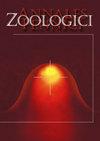相对于初级猎物数量的替代猎物的大小选择:松貂蛙狩猎
IF 0.9
4区 生物学
Q4 ECOLOGY
引用次数: 7
摘要
根据最优觅食理论,捕食者应该根据相对于处理时间的能量增益来选择最有益的猎物。对于松貂(Martes Martes)来说,银行田鼠等啮齿动物是主要猎物;然而,当啮齿动物数量较低时,松貂可以转而捕食各种次要猎物(如鸟类、水果和青蛙)。我们连续几年测量了在松貂粪便中发现的青蛙ilia,以评估被吃掉的青蛙的体重是否随着啮齿动物数量的变化而变化。啮齿动物密度与貂饮食中青蛙的出现频率呈负相关。此外,在啮齿动物数量较低的年份,松貂吃的青蛙比啮齿动物数量较高的年份小。在啮齿动物密度高的年份,青蛙的平均体重(18克)与田鼠的平均体重相似,这表明这种体型的猎物具有最佳的觅食努力与能量获取比例。在贫瘠的年份,貂捕食比平均田鼠体重小的青蛙,而在春天,这种青蛙大小的群体通常是环境中数量最多的。我们的研究结果表明,捕食者对低丰度初级猎物的功能反应不仅涉及猎物的切换,还涉及次级猎物数量的减少。食用青蛙的比例相对于年啮齿动物密度的波动会影响貂和青蛙的种群数量。本文章由计算机程序翻译,如有差异,请以英文原文为准。
Size Selection of Alternative Prey Relative to the Abundance of Primary Prey: Pine Marten Hunting for Frogs
According to optimal foraging theory, a predator should select the most beneficial prey in terms of energy gain relative to handling time. For the pine marten (Martes martes), rodents such as bank voles are the primary prey; however, the pine marten can switch to a variety of secondary prey items (e.g., birds, fruit and frogs) when the rodent abundance is low. We measured frog ilia found in pine marten scats during several consecutive years to assess whether the body mass of consumed frogs varied with changes in rodent abundance. Rodent density was inversely related to the frequency of occurrence of frogs in the marten's diet. Moreover, during the years with low rodent abundance, pine martens ate smaller frogs than in the years with high rodent availability. The average frog weight (18 g) during the years with high rodent density was similar to average vole weight, suggesting that prey of this size has an optimal ratio of foraging effort to energetic gain. During the lean years, martens preyed on frogs smaller than the average vole weight, and during spring this frog size-group is usually the most abundant in the environment. Our results suggest that functional responses of predators to low abundance of primary prey involve not only a prey-switch but also a decrease in the size of secondary prey consumed. Fluctuations in the proportion of frogs eaten in relation to yearly rodent density can affect both marten and frog population demography.
求助全文
通过发布文献求助,成功后即可免费获取论文全文。
去求助
来源期刊

Annales Zoologici Fennici
生物-动物学
CiteScore
2.40
自引率
14.30%
发文量
10
审稿时长
>12 weeks
期刊介绍:
Annales Zoologici Fennici publishes mainly original research reports, but also in-depth reviews and commentaries on all aspects of animal ecology and evolution, and fields related to them. Our aim is to promote papers which focus on the interactions among various components in the past and present environments by using integrative and cross-disciplinary approaches. This may be achieved by employing tools from different fields of research, such as (but not restricted to):
ecology and paleoecology,
molecular ecology and phylogeography,
conservation biology, human-induced contemporary evolution and wildlife management,
animal behaviour and interactions (including recognition systems and mechanisms),
paleontology (except systematics and taxonomy) and evolution,
bioenergetics.
 求助内容:
求助内容: 应助结果提醒方式:
应助结果提醒方式:


